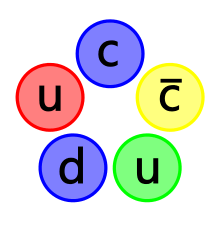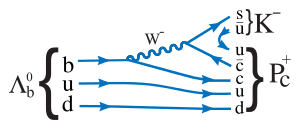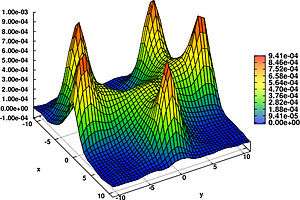Pentaquark


A pentaquark is a subatomic particle consisting of four quarks and one antiquark bound together.
As quarks have a baryon number of +1/3, and antiquarks of −1/3, the pentaquark would have a total baryon number of 1, and thus would be a baryon. Further, because it has five quarks instead of the usual three found in regular baryons (aka 'triquarks'), it would be classified as an exotic baryon. The name pentaquark was coined by Claude Gignoux et al.[1] and Harry J. Lipkin in 1987;[2] however, the possibility of five-quark particles was identified as early as 1964 when Murray Gell-Mann first postulated the existence of quarks.[3] Although predicted for decades, pentaquarks have proved surprisingly difficult to discover and some physicists were beginning to suspect that an unknown law of nature prevented their production.[4]
The first claim of pentaquark discovery was recorded at LEPS in Japan in 2003, and several experiments in the mid-2000s also reported discoveries of other pentaquark states.[5] Others were not able to replicate the LEPS results, however, and the other pentaquark discoveries were not accepted because of poor data and statistical analysis.[6] On 13 July 2015, the LHCb collaboration at CERN reported results consistent with pentaquark states in the decay of bottom Lambda baryons (Λ0
b).[7]
Outside of particle physics laboratories pentaquarks also could be produced naturally by supernovae as part of the process of forming a neutron star.[8] The scientific study of pentaquarks might offer insights into how these stars form, as well as allowing more thorough study of particle interactions and the strong force.
Background
A quark is a type of elementary particle that has mass, electric charge, and colour charge, as well as an additional property called flavour, which describes what type of quark it is (up, down, strange, charm, top, or bottom). Due to an effect known as colour confinement, quarks are never seen on their own. Instead, they form composite particles known as hadrons so that their colour charges cancel out. Hadrons made of one quark and one antiquark are known as mesons, while those made of three quarks are known as baryons. These 'regular' hadrons are well documented and characterized, however, there is nothing in theory to prevent quarks from forming 'exotic' hadrons such as tetraquarks with two quarks and two antiquarks, or pentaquarks with four quarks and one antiquark.[4]
Structure

c type pentaquark possibly discovered in July 2015, showing the flavours of each quark and one possible colour configuration.
A wide variety of pentaquarks are possible, with different quark combinations producing different particles. To identify which quarks compose a given pentaquark, physicists use the notation qqqqq, where q and q respectively refer to any of the six flavours of quarks and antiquarks. The symbols u, d, s, c, b, and t stand for the up, down, strange, charm, bottom, and top quarks respectively, with the symbols of u, d, s, c, b, t corresponding to the respective antiquarks. For instance a pentaquark made of two up quarks, one down quark, one charm quark, and one charm antiquark would be denoted uudcc.
The quarks are bound together by the strong force, which acts in such a way as to cancel the colour charges within the particle. In a meson, this means a quark is partnered with an antiquark with an opposite colour charge – blue and antiblue, for example – while in a baryon, the three quarks have between them all three colour charges – red, blue, and green.[nb 1] In a pentaquark, the colours also need to cancel out, and the only feasible combination is to have one quark with one colour (e.g. red), one quark with a second colour (e.g. green), two quarks with the third colour (e.g. blue), and one antiquark to counteract the surplus colour (e.g. antiblue).[9]
The binding mechanism for pentaquarks is not yet clear. They may consist of five quarks tightly bound together, but it is also possible that they are more loosely bound and consist of a three-quark baryon and a two-quark meson interacting relatively weakly with each other via pion exchange (the same force that binds atomic nuclei) in a "meson-baryon molecule".[3][10][11]
History
Mid-2000s
The requirement to include an antiquark means that many classes of pentaquark are hard to identify experimentally – if the flavour of the antiquark matches the flavour of any other quark in the quintuplet, it will cancel out and the particle will resemble its three-quark hadron cousin. For this reason, early pentaquark searches looked for particles where the antiquark did not cancel.[9] In the mid-2000s, several experiments claimed to reveal pentaquark states. In particular, a resonance with a mass of 1540 MeV/c2 (4.6 σ) was reported by LEPS in 2003, the
Θ+
.[12] This coincided with a pentaquark state with a mass of 1530 MeV/c2 predicted in 1997.[13]
The proposed state was composed of two up quarks, two down quarks, and one strange antiquark (uudds). Following this announcement, nine other independent experiments reported seeing narrow peaks from
n
K+
and
p
K0
, with masses between 1522 MeV/c2 and 1555 MeV/c2, all above 4 σ.[12] While concerns existed about the validity of these states, the Particle Data Group gave the
Θ+
a 3-star rating (out of 4) in the 2004 Review of Particle Physics.[12] Two other pentaquark states were reported albeit with low statistical significance—the
Φ−−
(ddssu), with a mass of 1860 MeV/c2 and the
Θ0
c (uuddc), with a mass of 3099 MeV/c2. Both were later found to be statistical effects rather than true resonances.[12]
Ten experiments then looked for the
Θ+
, but came out empty-handed.[12] Two in particular (one at BELLE, and the other at CLAS) had nearly the same conditions as other experiments which claimed to have detected the
Θ+
(DIANA and SAPHIR respectively).[12] The 2006 Review of Particle Physics concluded:[12]
[T]here has not been a high-statistics confirmation of any of the original experiments that claimed to see the
Θ+
; there have been two high-statistics repeats from Jefferson Lab that have clearly shown the original positive claims in those two cases to be wrong; there have been a number of other high-statistics experiments, none of which have found any evidence for the
Θ+
; and all attempts to confirm the two other claimed pentaquark states have led to negative results. The conclusion that pentaquarks in general, and the
Θ+
, in particular, do not exist, appears compelling.
The 2008 Review of Particle Physics went even further:[6]
There are two or three recent experiments that find weak evidence for signals near the nominal masses, but there is simply no point in tabulating them in view of the overwhelming evidence that the claimed pentaquarks do not exist... The whole story—the discoveries themselves, the tidal wave of papers by theorists and phenomenologists that followed, and the eventual "undiscovery"—is a curious episode in the history of science.
Despite these null results, LEPS results as of 2009 continue to show the existence of a narrow state with a mass of 1524±4 MeV/c2, with a statistical significance of 5.1 σ.[14] Experiments continue to study this controversy.
2015 LHCb results


b→J/ψK−
p decay, with each fit component shown individually. The contribution of the pentaquarks are shown by hatched histograms.
In July 2015, the LHCb collaboration at CERN identified pentaquarks in the Λ0
b→J/ψK−
p channel, which represents the decay of the bottom lambda baryon (Λ0
b) into a J/ψ meson (J/ψ), a kaon (K−
) and a proton (p). The results showed that sometimes, instead of decaying directly into mesons and baryons, the Λ0
b decayed via intermediate pentaquark states. The two states, named P+
c(4380) and P+
c(4450), had individual statistical significances of 9 σ and 12 σ, respectively, and a combined significance of 15 σ — enough to claim a formal discovery. The analysis ruled out the possibility that the effect was caused by conventional particles.[3] The two pentaquark states were both observed decaying strongly to J/ψp, hence must have a valence quark content of two up quarks, a down quark, a charm quark, and an anti-charm quark (
u
u
d
c
c
), making them charmonium-pentaquarks.[7][8][15]
The search for pentaquarks was not an objective of the LHCb experiment (which is primarily designed to investigate matter-antimatter asymmetry)[16] and the apparent discovery of pentaquarks was described as an "accident" and "something we’ve stumbled across" by a CERN spokesperson.[10]
Applications

The discovery of pentaquarks will allow physicists to study the strong force in greater detail and aid understanding of quantum chromodynamics. In addition, current theories suggest that some very large stars produce pentaquarks as they collapse. The study of pentaquarks might help shed light on the physics of neutron stars.[8]
See also
Footnotes
- ↑ The colour charges do not correspond to physical visible colours. They are arbitrary labels used to help scientists describe and visualise the charges of quarks.
References
- ↑ Gignoux, C.; Silvestre-Brac, B.; Richard, J. M. (1987-07-16). "Possibility of stable multiquark baryons". Physics Letters B. 193 (2): 323–326. Bibcode:1987PhLB..193..323G. doi:10.1016/0370-2693(87)91244-5.
- ↑ H. J. Lipkin (1987). "New possibilities for exotic hadrons — anticharmed strange baryons". Physics Letters B. 195 (3): 484–488. Bibcode:1987PhLB..195..484L. doi:10.1016/0370-2693(87)90055-4.
- 1 2 3 "Observation of particles composed of five quarks, pentaquark-charmonium states, seen in Λ0
b→J/ψpK− decays". CERN/LHCb. 14 July 2015. Retrieved 2015-07-14. - 1 2 H. Muir (2 July 2003). "Pentaquark discovery confounds sceptics". New Scientist. Retrieved 2010-01-08.
- ↑ K. Hicks (23 July 2003). "Physicists find evidence for an exotic baryon". Ohio University. Retrieved 2010-01-08.
- 1 2 See p. 1124 in C. Amsler et al. (Particle Data Group) (2008). "Review of particle physics" (PDF). Physics Letters B. 667 (1-5): 1. Bibcode:2008PhLB..667....1A. doi:10.1016/j.physletb.2008.07.018.
- 1 2 R. Aaij et al. (LHCb collaboration) (2015). "Observation of J/ψp resonances consistent with pentaquark states in Λ0
b→J/ψK−p decays". Physical Review Letters. 115 (7). arXiv:1507.03414 . Bibcode:2015PhRvL.115g2001A. doi:10.1103/PhysRevLett.115.072001.
. Bibcode:2015PhRvL.115g2001A. doi:10.1103/PhysRevLett.115.072001. - 1 2 3 I. Sample (14 July 2015). "Large Hadron Collider scientists discover new particles: pentaquarks". The Guardian. Retrieved 2015-07-14.
- 1 2 J. Pochodzalla (2005). "Duets of strange quarks". Hadron Physics. p. 268. ISBN 161499014X.
- 1 2 G. Amit (14 July 2015). "Pentaquark discovery at LHC shows long-sought new form of matter". New Scientist. Retrieved 2015-07-14.
- ↑ T. D. Cohen; P. M. Hohler; R. F. Lebed (2005). "On the Existence of Heavy Pentaquarks: The large Nc and Heavy Quark Limits and Beyond". Physical Review D. 72 (7): 074010. arXiv:hep-ph/0508199
 . Bibcode:2005PhRvD..72g4010C. doi:10.1103/PhysRevD.72.074010.
. Bibcode:2005PhRvD..72g4010C. doi:10.1103/PhysRevD.72.074010. - 1 2 3 4 5 6 7 W.-M. Yao et al. (Particle Data Group) (2006). "Review of particle physics:
Θ+
" (PDF). Journal of Physics G. 33: 1. arXiv:astro-ph/0601168 . Bibcode:2006JPhG...33....1Y. doi:10.1088/0954-3899/33/1/001.
. Bibcode:2006JPhG...33....1Y. doi:10.1088/0954-3899/33/1/001. - ↑ D. Diakonov; V. Petrov & M. Polyakov (1997). "Exotic anti-decuplet of baryons: prediction from chiral solitons". Zeitschrift für Physik A. 359 (3): 305. arXiv:hep-ph/9703373
 . Bibcode:1997ZPhyA.359..305D. doi:10.1007/s002180050406.
. Bibcode:1997ZPhyA.359..305D. doi:10.1007/s002180050406. - ↑ T. Nakano et al. (LEPS Collaboration) (2009). "Evidence of the Θ+ in the γd→K+K−pn reaction". Physical Review C. 79 (2): 025210. arXiv:0812.1035
 . Bibcode:2009PhRvC..79b5210N. doi:10.1103/PhysRevC.79.025210.
. Bibcode:2009PhRvC..79b5210N. doi:10.1103/PhysRevC.79.025210. - ↑ P. Rincon (14 July 2015). "Large Hadron Collider discovers new pentaquark particle". BBC News. Retrieved 2015-07-14.
- ↑ "Where has all the antimatter gone?". CERN/LHCb. 2008. Retrieved 2015-07-15.
- ↑ N. Cardoso; M. Cardoso & P. Bicudo (2013). "Color fields of the static pentaquark system computed in SU(3) lattice QCD". Physical Review D. 87 (3): 034504. arXiv:1209.1532
 . Bibcode:2013PhRvD..87c4504C. doi:10.1103/PhysRevD.87.034504.
. Bibcode:2013PhRvD..87c4504C. doi:10.1103/PhysRevD.87.034504.
Further reading
- David Whitehouse (1 July 2003). "Behold the Pentaquark (BBC News)". BBC News. Retrieved 2010-01-08.
- Thomas E. Browder; Igor R. Klebanov; Daniel R. Marlow (2004). "Prospects for Pentaquark Production at Meson Factories". Physics Letters B. 587: 62. arXiv:hep-ph/0401115
 . Bibcode:2004PhLB..587...62B. doi:10.1016/j.physletb.2004.03.003.
. Bibcode:2004PhLB..587...62B. doi:10.1016/j.physletb.2004.03.003. - Akio Sugamoto (2004). "An Attempt to Study Pentaquark Baryons in String Theory". arXiv:hep-ph/0404019
 [hep-ph].
[hep-ph]. - Kenneth Hicks (2005). "An Experimental Review of the
Θ+
Pentaquark". Journal of Physics: Conference Series. 9: 183. arXiv:hep-ex/0412048 . Bibcode:2005JPhCS...9..183H. doi:10.1088/1742-6596/9/1/035.
. Bibcode:2005JPhCS...9..183H. doi:10.1088/1742-6596/9/1/035. - Mark Peplow (18 April 2005). "Doubt is Cast on Pentaquarks". Nature. doi:10.1038/news050418-1.
- Maggie McKie (20 April 2005). "Pentaquark hunt draws blanks". New Scientist. Retrieved 2010-01-08.
- Thomas Jefferson National Accelerator Facility (21 April 2005). "Is It Or Isn't It? Pentaquark Debate Heats Up". SpaceDaily.Com. Retrieved 2010-01-08.
- Dmitri Diakonov (2005). "Relativistic Mean Field Approximation to Baryons". European Physical Journal A. 24: 3. Bibcode:2005EPJAS..24a...3D. doi:10.1140/epjad/s2005-05-001-3.
- Schumacher, R. A. (2006). "The Rise and Fall of Pentaquarks in Experiments". AIP Conference Proceedings. 842: 409. arXiv:nucl-ex/0512042
 . doi:10.1063/1.2220285.
. doi:10.1063/1.2220285. - Kandice Carter (2006). "The Rise and Fall of the Pentaquark". Symmetry Magazine. 3 (7): 16.